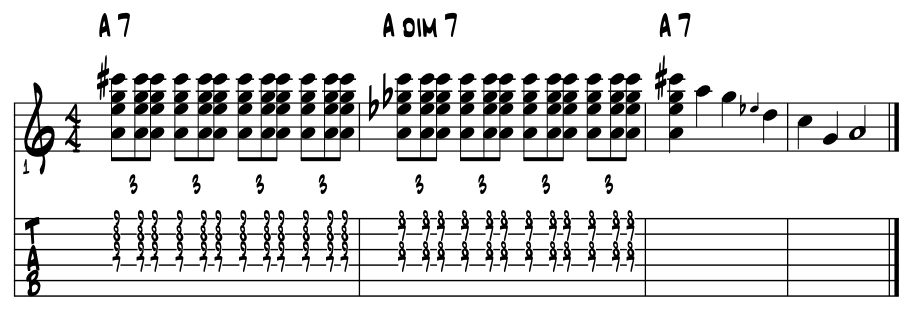~ Arpeggios ~ ~ groups of pitches evolve into arpeggios ~ ~ knowing that what goes up usually comes down :)
~ arpeggio powered evolutions ~ ~ a basis of through the changes improv ~
|
In a nutshell. New to arpeggios ? Easy fix, our same stepwise 'scaler' pitches now move from one another by leap (thirds), becoming an arpeggio. Thinking 'E' major; scale steps E F# G# A B C# D# E arpeggio leaps E G# B D# F# A C# E Steps to leaps of 3rd's ... easy :) Ya dig any sort of bass line boogie woogie magic? From any era, in any style? Cool. In this next idea, this arpeggio line in the bass has got to be among the easiest way to get the music, and the room, to dance. Here's the basis of the magic. Learn it here if need be. Ex. 0. |
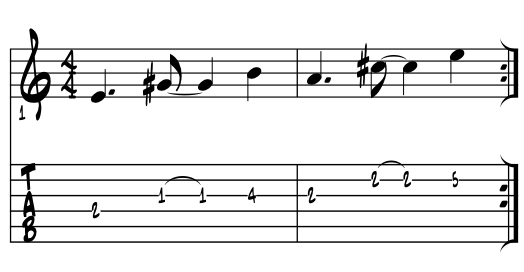 |
Triads. Aren't these 'mini arpeggios' triads too? Yep, both are major triads. Add a step to 6 and a 7th to create the cliche that launched a lot of songs. Example 0a. |
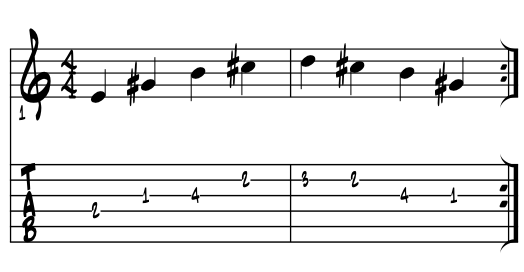 |
And that's the boogie woogie stride piano lick of the early 1900's that became rock and roll in the 50's ? Yep, that's the one, just up and down a dominant 7th arpeggio. A root position major triad with a b7. Set in motion by a quarter note, walking bass line. Cool huh ? |
|
The historical nut. In addition to the above new epoch creating lick, turns out that 'arpeggio figures' have no less than three times, with three distinct artists, clearly been an evolutionary catalyst in Americana jazz musics. In all these cases, a 'new thing' evolved organically and quickly through arpeggiating the pitches. Style, theory, the musics Americana landscape, all are brought to a new plane of understanding and creativity. Startlingly true too, that in theory, we can easily codify these evolutions in our numbers. And the 'additive properties' of our numerics guide our ways to gradually build and advance each of the seven diatonic positions. And the five in between too ? Yep. :) 7 + 5 = 12 |
Jazzy nutshell. Just turns out that even in music, that what goes up must come down. Gravity? Yep. So there's musical pitch gravity too? Yep. Like a tonal gravity? In some circles, yes, indeed. So within this next discussion of our melodic essentials, generally what goes up are the pitches shaped into arpeggios, and what comes down are pitches shaped in scales. Arpeggios become the launch energy for our idea, and we insure a safe landing, by scale stepping our way back to diatonic terra firma. Example 1. |
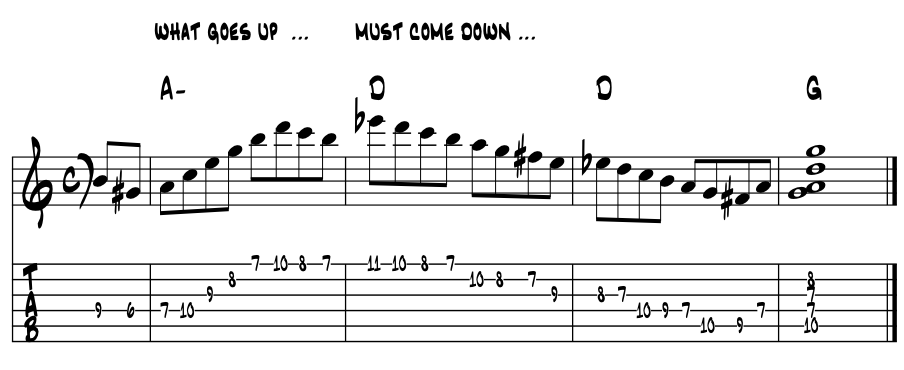 |
This last gem follows this general, jazzy rule of thumb for melodic invention; arpeggios up, scales down. Click for the music and follow along with the notation, solid way to begin to learn how to read music. Try the 'mini' for a brighter tempo version. |
A definition of a scale. A succession of notes, normally either a whole tone or a half tone apart, arranged in ascending or descending order. |
A definition of an arpeggio. The playing of a chord with its notes sounded in succession, rather than simultaneously. |
Arpeggios in a nutshell. So does a saxophone get to play chords? Do any single line instruments, can any of the horns, play chords? Can they sound out the pitches of chords? Turns out that there's a super handy, midpoint component between linear scales and vertical chords. Most all us theorists term this structure an 'arpeggio.' And arpeggios are what horn players use to play chords, a sort of 'broken chord', but chord nonetheless. So ... any chord at anytime, can be presented anywhere, in any style, by correctly sounding out the pitches of its arpeggio? Yep. :) Now a very old Italian term, according to the HBDM, 'arpeggio' comes to us today meaning 'harp like', as their pitches follow the traditional ways that harp strings are tuned and organized on our various 'harp like' instruments to sound their pitches. |
|
Created from any scale, arpeggios sequence a scale's pitches by skipping every other note, thus becoming the pitches of chords one by one. In the following idea, we sound out the 'C' major scale followed by arpeggiating the pitches of the 'C' major triad, in a linear, 'broken chord' shaped melody. Example 1a. |
|
 |
Cool? Easy do? Isn't that arpeggio melody the opening pitches to our national anthem? Sure is. So the national anthem starts with an arpeggio? Sure does. So this is how horns play chords, they play a chord's pitches one at a time, and in such a way as to create the impression of hearing a chord. Played successively, arpeggios give the impression of hearing a chord progression. |
So the gist of the following discussion is to understand how we can reconfigure the pitches of our diatonic major scale, and other groups of pitches too, into their 'harp like' shaped arpeggios, and of course exploring what ever else shakes loose along the way :) |
Here is the core transitioning of the letter name pitches of the 'C' major scale into the 'C' major arpeggio. Do rote learn this process and forever be empowered. Ex.2.
~ C D E F G A B C becomes C E G B D F A C ~
|
 |
That easy? Sure is. Didn't we just simply skip every other note of the scale to create its arpeggio? Sure did. And we need just 12 of these to make the whole tamale ? Yep. |
So just what is an arpeggio? This musical term comes to us from the Italian and translates to 'harp like.' According to HBDM, an arpeggio is 'the playing of a chord with its notes sounded in succession, rather than simultaneously.' Here's the the letter pitch evolution from scale to arpeggio with corresponding numbers. Thinking 'C' major. Example 3. |
|
scale degree |
root (1) |
2 |
3 |
4 |
5 |
6 |
7 |
8 |
scale pitches |
C |
D |
E |
F |
G |
A |
B |
C |
arpeggio degree |
root (1) |
3 |
5 |
7 |
9 |
11 |
13 |
15 |
arpeggio pitches |
C |
E |
G |
B |
D |
F |
A |
C |
So we can number our scale degrees, One through Eight for the octave closure. Arpeggio degrees go One to 15 to close, thus encompassing two full octaves. Do rote memorize this chart. From this basis we create all of our diatonic, chord spelling charts. |
Arpeggios in the music. Well just about everywhere in the literature. Many cherished children's songs and folk songs are based on arpeggiating the pitches of the major triad. Americana folk classics "Oh Susanna", "Michael Rowed The Boat Ashore" and "Kumbaya" come right to mind. Led Zeppelin guitarist Jimmy Page's opening lick of their epic song "Stairway To Heaven" is an arpeggiated tonic minor 9th chord. So sounding chord pitches in succession is common and cool and for us theorists, we simply call them all arpeggios. |
|
Metal players love these things. Arpeggios are perfect for their sweep and double picking techniques across multiple strings and when rapidly executed, can create a very dramatic musical effect through a dimed, crunchy stack. In blues and rock? Here and there, often when chords are slowly strummed as arpeggios. In both these styles and hybrid genres, their bass lines love the arpeggios. In pop? For sure as so many of the background synth loops are arpeggios. In jazz? Verily verily absolutely in jazz, all styles and genres as players often improvise 'through' the changes. |
For guitar and string players in general, the arpeggios are a dream come true. There's easily a half dozen, fully movable shapes that can blaze right up at any moment that accurately and to a 't', portray the harmony of any given moment in a song or its chord progression. At their core, the major and minor triad shapes seem built right into the frets, they move right around, both up and down and across the strings. So initially, just a few core shapes to master. Here they are in 5th position. Example 3a. |
 |
We can grab this first shape and make a nice little exercise around and across the strings. Listen for the 'changes' in the melody line. Example 3b. |
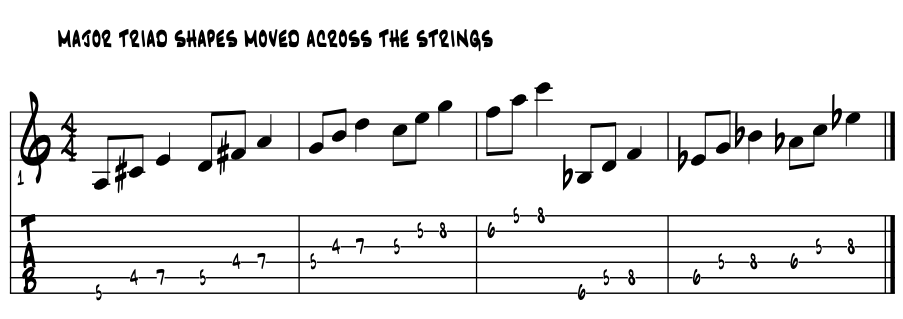 |
Cool? There's an 'exercise' for ya ! So, most jazz players will deeply shed the arpeggios. Horn players for sure, for while their instruments can't sound out chords, they sure can create accurately pitched arpeggios, thus can clearly outline and chord changes perfectly at blistering tempos. Here's a totally Americana arpeggio idea hinted at above, and along these lines. Do get it under your fingers here if need be. Example 3c. |
 |
Surely we've heard this arpeggiated idea somewhere sometime someplace in the Americana library? Along this line, a few of the jazz legends of the last 100 years were not only the arpeggio kings of their local universe but the top innovators of their chosen field of art as well. |
Why's that? In jazz music, at least back when it mattered, it was important to clearly hear the chord changes in the melodic line. This was the basis of the art, the learning and its evolutions. So when chord progressions get busy and thicken up, arpeggios come right to the rescue. For they not only clearly outline the harmony and chord progression of the song but also can generate a startling degree of vitality and sense of forward motion. |
At the core of this evolutionary process. So the basic twist of the theory, in creating arpeggios from scales, is to simply move from our stepwise, whole step / half step scale construction to what we term tertian motion, or pitch movement by the interval of a third; both the major and minor third intervals. And in having fun with the reality of it all, our scale evolves into its arpeggio simply by consistently skipping every other note in the group. |
Need two full octaves. For purely theory sake, and of course to retain its perfect closure, we'll use all of our scale pitches in the following example. Please note that in this scale to arpeggio conversion process, to get that closure, we do have to expand our range of pitches from one octave (scale) to two full octaves to create our arpeggio. Example 3d. |
 |
Did ya think it would be so easy? So the only real trick is to respell scales by skipping pitches? Pretty much. Same with arpeggiating our other scale groups? Pretty much, actually that's an absolute yes. Here are the letter name pitches of the 'C' major scale then respelled out as its 'C' major arpeggio. Example 3e. |
C major scale |
C |
D |
E |
F |
G |
A |
B |
C |
C major arpeggio |
C |
E |
G |
B |
D |
F |
A |
C |
Quick review. Let's dig back into the major scale formula to ensure that we got this all correct. We can simply look at the distance between the pitches of our arpeggio and then compare them to that section of the major scale formula. Here is the whole step / half step formula and the pitches of the 'C' major scale followed, by the arpeggio breakdown. Example 3f. |
major scale formula |
1 |
1 |
1/2 |
1 |
1 |
1 |
1/2 |
|
C major scale |
C |
D |
E |
F |
G |
A |
B |
C |
C to E |
two whole (1) steps |
= major 3rd |
||||||
E to G |
1 + 1/2 step |
= minor 3rd |
||||||
G to B |
1 + 1 |
= major 3rd |
||||||
B to D |
1/2 + 1 |
= minor 3rd |
||||||
D to F |
1 + 1/2 |
= minor 3rd |
||||||
F to A |
1 + 1 |
= major 3rd |
||||||
A to C |
1 + 1/2 |
= minor 3rd |
||||||
So all looks groovy in theoryville yes? Pitches and intervals all check out ok. Do examine the right column sequence of the major and minor 3rd intervals. First we alternate major / minor / major / minor but then the pattern breaks. What significance might that repeated minor third interval; from 'B to D and D to F' create ? Hmmm ... surely there must be something cool in there. So the diatonic arpeggio, the major / minor of 3rd's cycle is organically imperfect as an alternating episode ? It is. And what if we were to 'correct' this pattern? And create a perfect alternating of major and minor 3rds, or vice versa, minor and major 3rd's. Would we still find our way to a perfect closure of the pitches? |
Are arpeggios always built in 3rd's? Pretty much. Building up groups or scales are generally whole steps and half steps. Major and minor thirds are for building up the arpeggios. We theorists call it tertian harmony, and it runs the show of Americana chords, 24 / 7, day in and day out. While we've additional scales, arpeggios and chords, constructed with perfect fourth intervals we term quartile, and even beyond fourths too, but the thirds of tertian harmony are our Americana mainstays through a wide spectrum of styles. |
Thinking modally. When creating our discussion of groups of pitches, we discovered that our musical / pitch resources are built in such a way so that each of the seven pitches of the major / relative minor group can become a tonic pitch. That historically by 1600 or so, these seven modes ended up under the shell of the relative major minor pairing and perspective. Then by shifting our start point in the loop of pitches, our interval formula also evolves, to create the seven unique whole step / half step formulas for the original seven modes from antiquity. |
So might we do the same in creating our arpeggios? Can we build an arpeggio from each of the pitches of the major / relative minor scale? Absolutely. Lest we forget that in theory, and thanks to equal temper tuning, the idea of 'anything from anywhere' is a mantra worth exploring. Examine the letter name pitches of the seven modes from the root pitch 'C.' Example 4. |
arpeggio degrees |
1 |
3 |
5 |
7 |
9 |
11 |
13 |
15 |
C Ionian |
C |
E |
G |
B |
D |
F |
A |
C |
D Dorian minor |
D |
F |
A |
C |
E |
G |
B |
D |
E Phrygian minor |
E |
G |
B |
D |
F |
A |
C |
E |
F Lydian major |
F |
A |
C |
E |
G |
B |
D |
F |
G Mixolydian major |
G |
B |
D |
F |
A |
C |
E |
G |
A Aeolian minor |
A |
C |
E |
G |
B |
D |
F |
A |
B Locrian minor |
B |
D |
F |
A |
C |
E |
G |
B |
Here are the pitches of the above chart with a suggested fingering for guitar. Example 4a. |
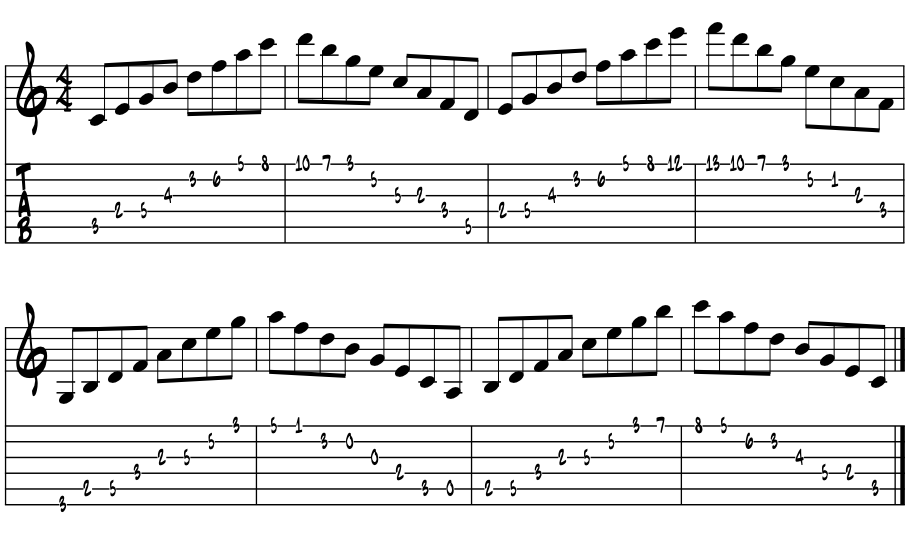 |
Quite a challenge. This last idea is a rather challenging fingering endeavor even for very experienced players. In other realms, we often lessen the number of pitches for each arpeggio, as say in our interval studies, with triads and 7th chords, or when soloing through changes. For those whose ambition shows no bounds, striving to get this lick under your fingers in one key, at any tempo, will open up a rather huge vista of potentials. For these sorts of exercises will get us to places on our instruments we might not ever get to. And once arrived there, discover something new. |
Jazz guitar. Another approach to arpeggios for guitar is to 'take what is given' in a single position or localized area on the fingerboard. In this approach, we find the different start points of each arpeggio in any one scale shape and just max out what it provides in that localized area. Again, the initial shedding is with triads and then 7th chords. These pitches suffice to give us each mode's basic color and chord type to work with. Down the road we'll add additional color tones to 'jazz up' an arpeggio run as our own mojo kicks on in. |
Modal arpeggios. And isn't this last lick some sort of sequence? Yep. Maybe even a Baroque sequence? Hear the chord changes in the line as the idea unfolds? Click it again, and then again and then again, if need be, but listen to hear the chord changes in the melodic line. To get a sense of the chords and their progression being outlined in the melody line. Here the above line again, but simplified to first triads then added 7ths. Example 4aa. |
 |
Cool? Hear the changes in the line? Try the fast version too, uptempo arpeggios. So this is one essential aspect, to clearly hear the chord changes in single note melodic lines, is what every single line instrument can do to 'play chords.' Further, this one melody / chord principle has historically been a basis of creating improvised art. Author's note. In my 'jazz 101' class, our academic grade was mostly based on this principle. The 'art' mattered too, but if Doc could not hear the 'changes in the line', he stopped to fix it. |
Any scale groupings? So can we apply the above theory to create arpeggios to any of our scale groupings? Absolutely. Create any of the above modal arpeggios from any of our 12 pitches of the chromatic scale? Absolutely, for that is the simply beauty of equal temper tuning, any and every component from any pitch. |
Any lick, riff, scale, arpeggio, chord or song, concerto or symphony from any of our 12 pitches, all in tune the way we hear the pitches in our modern times. Really ? Sounds like a stretch and in some cases it surely is, but in theory, all within is potentially possible yes? Just a matter of folks figuring it out. |
"It always seems impossible ... until it's done." |
wiki ~ Nelson Mandela |
Thinking minor key. Let's pick a new group of pitches, filter it through our scale / arpeggio theory, and see what shakes loose. Of course all of the diatonic modes live within the pitches of the relative major / minor scale. So let's try something a wee bit more exotic, say harmonic minor ? Cool, here goes. Let's first compare the pitches between the 'C' natural minor and the 'C' harmonic minor groups in letter and sound. Example 5. |
scale degrees |
1 |
2 |
3 |
4 |
5 |
6 |
7 |
8 |
C natural minor scale |
C |
D |
Eb |
F |
G |
Ab |
Bb |
C |
C harmonic minor scale |
C |
D |
Eb |
F |
G |
Ab |
B |
C |
natural minor |
harmonic minor |
 |
|
Old # 7. Octave leap to jump start the line, we sense that the pitches are identical except for the 7th scale degree. And they are. In our harmonic minor group, we approach our tonic pitch C from half step below. This evolves our 7th scale degree from a blue or minor 7th to a leading tone 7th, same one as in the relative major scale. Theoretically, this one pitch difference opens us into a new window of opportunity, one which has a potentially stunning musical and theoretical vista for those so inclined to explore. Now identifying this one pitch, yet crucial difference, between our natural and harmonic minor groups, let's morph our 'C' harmonic minor scale into its arpeggio. Example 5a. |
numeric scale degree |
root (1) |
2 |
3 |
4 |
5 |
6 |
7 |
8 |
C harmonic minor scale pitches |
C |
D |
Eb |
F |
G |
Ab |
B |
C |
numeric arpeggio degree |
root (1) |
3 |
5 |
7 |
9 |
11 |
13 |
15 |
C harmonic arpeggio pitches |
C |
Eb |
G |
B |
D |
F |
Ab |
C |
The intervals. Let's examine the intervals between the pitches of our harmonic minor arpeggio. In creating any minor arpeggio we always start off with a minor third interval first. Perhaps verbalize the following intervals of this chart the following way. 'C up to Eb' is a minor 3rd, 'Eb up to G' is a major 3rd etc. Example 5b. |
arpeggio degree |
root |
3rd |
5th |
7th |
9th |
11th |
13th |
15th |
interval |
. |
minor 3rd |
major 3rd |
major 3rd |
minor 3rd |
minor 3rd |
minor 3rd |
major 3rd |
C harmonic minor arpeggio |
C |
Eb |
G |
B |
D |
F |
Ab |
C |
. |
. |
C ~ Eb |
. |
. |
B ~ D |
D ~ F |
F ~ Ab |
. |
The results. Interesting eh? Well the initial minor 3rd, right above the root, defines our tonic triad as minor. Then two major 3rds in a row. Two consecutive major 3rds, so a bit of whole tone color maybe? Surely 'Eb, G and B' qualify for building up an augmented triad. Then what's up with that group of three minor 3rd intervals? Let's examine these two mini-groups that live within harmonic minor. But first we should hear the scale and its arpeggio yes? Example 5c. |
A rather nice mix of colors is this harmonic minor group. Minor tonic triad of course, minor 6th interval is needed to diatonically create the minor Four chord, and capped with the harmonic minor leading tone 7th. While harmonic minor might be a wee bit exotic for our mostly major key, diatonic Americana musical ears, the mode built on its 5th degree is a core grouping for the Klezmer artists. Examine their pitches, thinking 5th mode 'C' harmonic minor, so 'G' Klezmer. Example 5d. |
numeric scale degree |
root (1) |
2 |
3 |
4 |
5 |
6 |
7 |
8 |
C harmonic minor scale pitches |
C |
D |
Eb |
F |
G |
Ab |
B |
C |
numeric arpeggio degree |
root (1) |
3 |
5 |
7 |
9 |
11 |
13 |
15 |
G harmonic minor Klezmer |
G |
Ab |
B |
C |
D |
Eb |
F |
G |
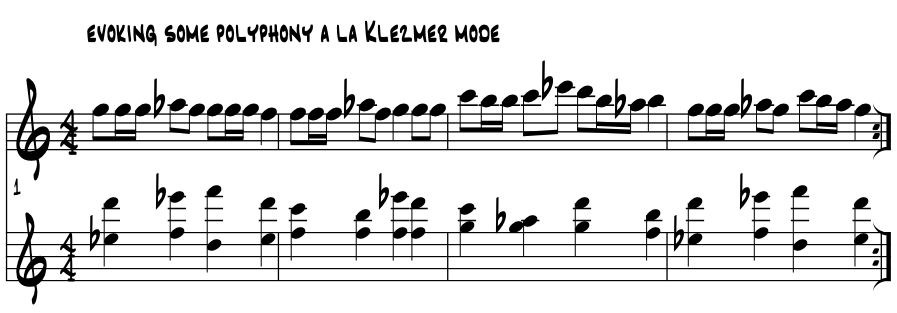 |
Some old world exotics eh ? The rhythms help to capture the emotion. What words do these pitches inspire for ya? Hip to the Klezmer library of musics? Talk about ancient, wow, and when done as a sort of polyphony, as in this last idea, ancient wows POP in its historical magics :) Capture the magic and loves of your life in your music. |
|
Three minor third intervals. And what of the three minor intervals from this harmonic minor arpeggio? Examine the pitches. Example 5e. |
arpeggio degree |
root |
3rd |
5th |
7th |
9th |
11th |
13th |
15th |
interval |
. |
minor 3rd |
major 3rd |
major 3rd |
minor 3rd |
minor 3rd |
minor 3rd |
major 3rd |
C harmonic minor arpeggio |
C |
Eb |
G |
B |
D |
F |
Ab |
C |
. |
. |
C ~ Eb |
. |
. |
B ~ D |
D ~ F |
F ~ Ab |
. |
Diminished colors. Stacking minor 3rds creates diminished color yes? And three will combine into the fully diminished 7th chord? Yes. And the fully diminished 7th chord, and its own symmetrical diminished scale, theoretically opens us into a whole new realm of convergence possibilities? It can, want to 'jazz up' up your musics ? Some added diminished color just might do the trick. But where ... ? |
As a core group for composing melodies, thanks to its whole tone and b9 components, harmonic minor's sound is a nice challenge to making art. So compose a song with the pitches. Find the pitches that make your hair stand up a bit. Then ya got them, and can borrow them when needed, to spice up spots in other songs and of course, to make folk's hair stand up with a magic note or two. |
Whole tone / augmented triad. Also from within the harmonic minor group, thinking from the minor 3rd 'Eb' above the root, we can build an augmented arpeggio / triad; 'Eb, G, B', which is simply a major triad with its 5th, augmented up by half step. Thinking concert pitch, 'Eb, G and B', variously arranged, these are rather famous among jazzers. Example 6. |
arpeggio degree |
root |
3rd |
5th |
7th |
9th |
11th |
13th |
15th |
interval |
. |
minor 3rd |
major 3rd |
major 3rd |
minor 3rd |
minor 3rd |
minor 3rd |
major 3rd |
C harmonic minor arpeggio |
C |
Eb |
G |
B |
D |
F |
Ab |
C |
. |
. |
. |
Eb ~ G |
G ~ B |
. |
. |
. |
. |
The diatonic leading tone 7th in this grouping, the pitch 'B' natural in relation to our root pitch 'C', provides that essential bit of closure and final sense of resolution in the minor tonality. Example 6a. |
 |
Perfect arpeggio inversions. From examining these three pitches we can see that each can become the root of an augmented triad. Examine the following chart. Do watch for enharmonic spellings with the letter name pitches. Example 6b. |
augmented triad |
1 / root |
major 3rd |
augmented 5th |
Eb augmented |
Eb |
G |
B |
G augmented |
G |
B |
D# (Eb) |
B augmented |
B |
D# (Eb) |
F## (G) |
Cool with the respelling ? Tricky but true :) ... and can you spell your chord ? Any chord ? |
Where in the music? The augmented color, in the minor tonality, is very often associated with the Five / One cadential motion, as Five and One share what we term a common tone pitch; augmented 5th of V7 = the blue 3rd of our tonic key. Here's a couple of root position chord ideas from two different sets of strings, resolving the augmented colors to a minor tonic. Example 6c. |
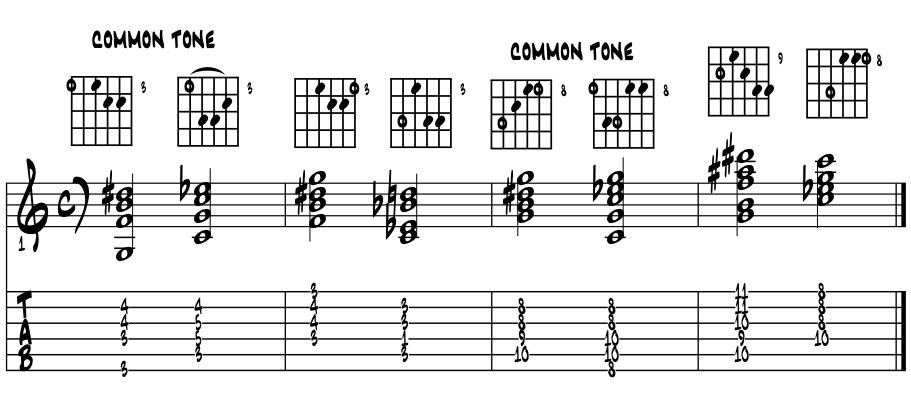 |
Sound familiar? Rather common in blues and jazz. And though rare in other styles, the augmented triad is often the perfect color piece to complete a song's puzzle. |
Where else in the music? We can find the augmented color being used in a major key in the harmonic motion between One and Four. In this next idea, the augmented 5th creates a nice chromatic motion to the major 3rd of the Four chord. I, V7 of IV to IV. Example 6d. |
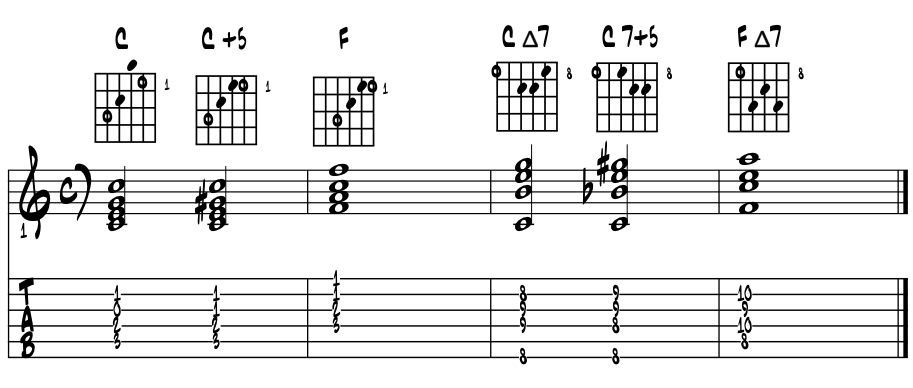 |
So not too common in the literature but a sure, strong aural character when needed. Check out the Dave Clark Five's "Because" from back in '64 for some very nice augmented chord motion in a solid pop setting. As this tune went to #3, big money maker for the band. And if your band plays weddings, might be a keeper. |
|
V7b9 is diatonic to harmonic minor. So, three minor 3rd intervals in a row is super rare and a one of a kind really, this must be something unique yes? Hip to the fully diminished 7th color? By thinking from the pitch 'G' in the above example, we spell the 'G7b9' chord from the 'C' harmonic minor arpeggio, created by simply skipping every other note. Example 7. |
C harmonic minor arpeggio pitches |
C |
Eb |
G |
B |
D |
F |
Ab |
C |
See the fully diminished 7th chord pitches in the upper part of a V7b9 chord? 'B D F Ab?' Tis indeed the case my friend. This organic harmonic minor source, along with the symmetrical diminished scale, are the only two groups that generate this essential (for some) color. Dig the V7b9 in action. Example 7a. |
Sorry about that closing melody ... for surely our V7b9 is not all doom and gloom :) |
Where in the music? V7b9 is occasionally in the blues, for in the older Delta styles it subs for a tonic chord. And of course in jazz influenced blues, which has everything. So any blues influenced might have a spot or two for this unique color. We do hear the diminished chord as a passing chord in pop music, though rarely. Here's the 'tonic dim sub' for a delta style, thinking blues in 'A.' Example 7b. |
|
In Americana jazz is where the V7b9 / diminished color and its associated magics come to a full fruition, both as a compositional color and theory portal, getting us to additional tonic points far beyond the traditions of the diatonic realm. Tonal convergence is the fancy title that heads up and combines the motions to Four, chord substitution, 'the how we get there from here departments.' |
Quick review / V7b9. So not only as a chord itself, but with its structural theory, we'll derive a whole family of chord substitutions and refreshing non-diatonic harmonic motions from its multiple leading tone properties. For it just turns out that each of the four pitches of the fully diminished 7th arpeggio are also potential leading tones themselves. Really? Yep. Like four 'major 7ths' in one chord? Yep. Exactly. Resolving to both major and minor key centers? Parallel key centers too? But of course. And U knew this :) Click any link to further explore. |
Americana jazz arpeggio kings. Coleman Hawkins might be the first. Mr. Hawkins' now famous solo on the classic song "Body and Soul" in 1939 is the second UYM kaboom moment in our Americana music history studies. For it pioneered a brand new approach to jazz improvisation. How so? Well ... |
|
A pioneering solo. By mainly using the arpeggio pitches of each chord in this song's chord progression, Hawkins' deftly improvises a new melody line that captures both the song's loving, devotional character and its bass line story, recreating its tensions and resolutions with arpeggios. |
It's theory. By consistently arpeggiating each chord, and adding his own artistic signature and mastery of the saxophone, these combine to become a sort of 'first of its kind', super clear and solid improv 'through the changes' arpeggiated solo. |
And with a touch of 'chromatic enhancement', which in sound and theory become the bluish notes, Hawkin's records and releases what becomes in 1939, a new soloist model, one that arpeggiates each chord, and includes all 12 pitches along the way. We today still use this improvisational model for a lot of solos. Blues infused arpeggios rule ! :) |
Recording and radio. Hawkins' historic solo, studio recorded, released on vinyl and over the airwaves, was heard by everyone in the jazz scene. With its languidly beautiful pulse of energy, with a combination of a laid back tone and the excitement of surprise, wider interval leaps, the arpeggiation of the written chord changes and no real signs of the written melody. This we can confidently term; soloing through the changes. For even without the rhythm section backing, astute listeners will hear the chord changes clearly in the improvised melodic line. Every pitch fits into every chord. Like J.S. Bach? Exactly :) |
A new world for improv. For prior to this pioneering improvisational approach, cats stuck closer to embellishing the melody of the song. Once the lid was off to 'soloing through the changes', a new world of Americana jazz improvisation began to take shape. For when combined with melodic embellishment, we have our two basic approaches for creating the improvised dialogue of today. |
Author's note. In me earlier days, when getting started with the music, and at least a couple of times this happened, I heard from different cats the way cool idea that ... 'if you spin Hawkins on 78, he sounds just like Charlie 'Bird' Parker. |
|
Charlie Parker. A younger Parker hears Hawkins perform and has heard and probably memorized this recording. Once newly 'hawk' empowered, Parker's further explorations expands this approach to a new level of potential. For he extends the "Body And Soul", Hawkin's styled arpeggios of mostly 1 3 5 7, to now complete the upper diatonic color tones, so 9 11 13, and of course includes all the blue notes in between :) All this happens in fast tempos, and even sometimes in tempos as fast as the humanly possible, and in this format, Americana bebop comes alive. |
|
Thrilling to behold, the bebop style, 'bop', is near if not at the pinnacle, for the combined performance challenges any music has ever presented for an artist. Quoting Parker, we basically have to know our horns, then forget it, and play jazz. Bop is really the whole tamale cooked into brighter tempos. That we've clear paths to follow that 'train us up', to conquer some of the 'be' in 'bebop', starts us off towards the pinnacle of our own Mt. Parnassus. |
|
For those players that develop some 'bop chops', and understanding of its theory, they can usually handle just about everything else that might come along, folk, pop, blues, blues, rock, rock blues, country, country blues, bossa, jazz and beyond. In all of our Americana, 'boppers' can usually find something to say and play in all musical genres, that'll help to make a groove and song swing and soar a wee bit more, all thanks to the pioneering works of 'Bird and Hawk.' :) Leaning towards becoming a jazzer? By all means then, study some bebop. |
So by early 40's, Parker and friends' '12 tone blues hued arpeggio' abilities and technique are (the) 'new' palette of the day. Bebop's popularity will last a decade or so and by the mid 50's, evolve into 'hard bop.' For folks still wanted to go to the clubs and dance, dance slow sometimes, and hear the true blue colors back in a more traditional gospel format too. And by the 50's, popularity of the jazz styles was waning towards rock and roll, which would soon become Americana's new 'popular' music. |
|
So we've a solid 50 + Parker composed songs to explore. And for those that dig it, we can hear their audio too, this music racing through time. In Americana theory, Parker's compositions ... ' become the Bach and beyond of jazz Americana.'
|
|||||||||
History review, 'Bird had the new word ... Bebop.' So within a decade or so of Mr. Hawkins' new approach to jazz improvisation, composer, ascending alto saxophonist Charlie Parker becomes the reigning arpeggio king of NYC and its environs, evolving the music of his day in a couple of essential ways. One was in the harmony. How? Well, Mr. Parker explored nearly every nook and cranny of our diatonic harmony, and their possible colortone extensions, in both his written songs and improvisations. We oftentimes will see a complete cadential motion to get to each new key center, creating opportunity for single note lines of convergence. We can hear this approach in his many compositions and improvisations, all containing a solid base of the essential Americana blue. |
|
Parker's magic moment. Mr. Parker's biographers reveal to us one of his early 'Parnassus' moments; that while warming up before a show, by running the changes of the song "Cherokee", a favorite of the day, Parker first realized (?) that if he outlined the chord quality of each chord, by simply sounding out its pitches as an arpeggio, he then had the basis and a sound context, to create melodic ideas with the upper color tones.
These being diatonic, and supported by the initial arpeggio, now sounded 'correct' in the music stylings of his day. Innovative? Absolutely. Provocative? Yep. In theory 'correct?' Perfect, in so many new ways. For melody notes, blue notes, the rhythms, that years into future decades would pass before fully understood. |
|
||||||||||||
In doing so, Using an arpeggio, chord type launch pad, Mr. Parker's deeper harmonic explorations, into the higher pitches of the arpeggio, made a lot more sense to everyone involved. We must remember that in this era, cats were still improvising exclusively inside the changes. Can't clearly hear the chord changes in the improvised line? Not a good thing. Playing outside the changes? Not quite yet, it'll be another dozen years or so of evolutions to get the improvisational arts there. |
Fast arpeggios. We should also keep in mind that jazz was America's 'pop' music of the 1940's, and the folks buying records, thus paying the music biz bills, wanted to understand the music's creative excellence too. Thus everything, all the notes and chords combined, fits 'inside.' Mr. Parker also played very very fast, so his arpeggiated ideas could have sounded just like chords to folks, when heard live in the club? Musing aside, surely this sets the table for John Coltrane's 'sheets of sound' arpeggio approach, which follows Mr. Parker a decade later, and does indeed sound just like chords :) |
Quick review. So in regards to the upper extensions, or color tone ideas that Mr. Parker explored in his improvisations, which were pushing the existing boundaries of what was considered 'inside', first by launching his line with the '1 3 5 7' arpeggio pitches of the written chord, he created a sort of launch pad type springboard, that enabled the upper part of his ideas make solid, good, clear, inside musical sense to near all listeners, those who could hear Bird's ideas and understand the art, as well as those who just jazzed along and could care less about music's architectures. The folks dug the super positive charged energy of the art. |
So into the wayback, this time to NYC 1945 or so, imagine the 'establishment' hearing Charlie Parker, then in his mid 20's, use his extended arpeggios to play perfectly, inside through the changes, fastest and most harmonically involved cycles of 'standard' chord changes ever produced, weaving his improvised line inside every nook and cranny of the harmony. Surely news of the new 'bebop' spread like wildfire among the music community. |
Today as I write this 70 years or so later, are Mr. Parker's solos part of the collection of artistic perfection for his day? That the analysis of transcriptions of his work neatly proves up the theory, an ancient theory that we still write down with 1000 year old symbols today, modernized to our present day notation. And as a bonus, but more as a basis, Mr. Parker includes a healthy dollop of the original Americana bluesy hues throughout; new melodies, chord progressions, licks and cliches, even a Latin leaning blues song. Same 12 bar form? Yep. And I don't know of any Parker blues songs that vary in this form. Simply remarkable. |
Here's an arpeggiated idea similar to one Mr. Parker created in bar 22, page 3 of his solo on 'Confirmation' in 'F' major from the 'Omnibook.' Thinking Two / Five / One heading to Four, 'Bb.' Example 8. |
 |
The opening arpeggio of the line perfectly outlines the extended pitches of the 'C' minor 7 chord up through its natural 11th, providing a perfectly 'inside' start for the chromaticism that follows over the dominant chord 'F7.' |
The Trane is coming. By the mid 50's, and emerging from the tail of Mr. Parker's comet, tenor saxophonist and composer John Coltrane continues the ascension to become the new arpeggio king of the jazz universe. Eventually eclipsing Parker, Coltrane's blistering ... 'sheets of sound' ... ... of his middle artistic period, becomes the super fast articulation of any chord's pitches, sifting through permutations of its parent scale and arpeggiated lines. Furthering his own challenge, Coltrane applies this 'sheets of sound' searching through the advancing complexity of chord substitution that he himself has pioneered in the writing of his compositions. |
|
Building on Mr. Parker's earlier contributions, both of these arpeggiated explorations advanced the music of their day and in many ways, we can still hear the echoes in today's jazz. While Mr. Parker's advancements founded bebop, a musical style, Mr. Coltrane's searching and development culminated in a revolutionary new harmonic and compositional scheme based on yea ... you guessed it, an arpeggio :) Coltrane's combined harmonic and melodic scheme created a new approach to melodic improvisation over conventional chords, now moving, at least in 1960, in unconventional ways. |
From this work a whole new 'school' developed for the use of the pentatonic colors in jazz improvisation. And as jazz and rock began to melt together in the 60's and forward, artists used Coltrane's basis to fully explore the pentatonic potential through all 12 pitches, so as to include all of our color tone pitches available on any chord that comes along. Substitutions too? Yep. |
Thanks to Coltrane's explorations, any and all chord tones, diatonic or altered, are potential root pitches upon which to build a pentatonic group / color to convey the qualities of each chord that comes along in our songs and progressions. We can now apply our original 'magic of the pentatonics' in any permutation we conceive. And just like with the evolutions of Hawkins and Parker, we always could ... but nobody did, till Coltrane's evolutions discovered this new pathway for us all. Thanks JC! |
One result of these 'inside' explorations is the real beginning of the 'outside' school of improvisation. Improvised melodic lines are no longer dictated by the harmony. As this music develops, the written harmony can be eliminated, freeing up melody of the combined instruments. Its spiritual mentor and pioneering artist is saxophonist Ornette Coleman. Taken together, we arrive today with our full spectrum palette, fully capable of creating our modern jazz language. |
|
Arpeggios in rock and pop. As Americana jazz evolved towards a more chromatic texture in the early 60's, our core 12 bar blues again became the source for the next new Americana sound. Early fifties rock'n roll is straight up 1 4 5 ~ 12 bar blues, and soon becomes America's new popular music on the radio. "Johnny B. Goode" by guitarist Chuck Berry in 1958, gave guitarists a whole new world of potentials in a tried and true musical form, that is still cruising right along today, on any given Saturday night, in any club that's got a blue hue. |
|
Early rock major triad / arpeggio bass line. Resurrected straight out of the school of 'stride' piano from the 1920's, this next idea gets us right back to where we started at the top of this discussion. Triads? Yep, three note triads. Our 'mini' arpeggios :) This next idea is now just a super cliche arpeggio bass line from the early rockers, that we can find in lots of spots in the literature. Learn this one here if needed. Motion from One to Four. Example 9. |
|
 |
Now this lick? Cool. No ? Learn it here then. Run it through a few keys and yea, covers lots of spots in lots of songs. Catch the extension to the 7th in bar 3? And then the walking motion ... ? Push a bit on 2 and 4 and the swing thing comes to life :) |
Arpeggios in rock. As mentioned above, Led Zeppelin's Jimmy Page's opening lick in 'Stairway To Heaven' is an arpeggiated minor 9th chord. While not an overly common rock color, it surely sets the mood for what follows in this epic tune yes? Chicago's pop / wedding song ballad 'Colour My World' opens with a repeated major 7th arpeggio figure. |
|
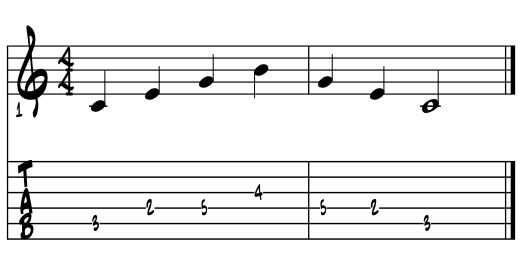 |
Often associated with pop music, the major 7th sound is a real transition point in the theory / musical styles. All three of these above mentioned tunes are instantly recognizable from their opening arpeggio licks and surely have generated some serious mailbox loot over the years. |
Bass lines / arpeggios. Bass players love the arpeggios in creating their lines, using their leaps to motorize our grooves and totally state the harmony and chord progressions of any song. The three notes of the triad is most common, with the blue or major seventh added depending on the style. And while advancing bass cats will play actual triads, some to a very advanced level, chords in this lower bass register or pitch range can be cumbersome. So sounding out the pitches of each chord with the 'arpeggiation of their pitches' rules the day. |
Here are two quite popular arpeggiated bass lines taken from the blues / rock styles, both notated for guitar. The first half of the example are triads created from the One and Four scale degrees. The second idea extends up to the blue 7th of the V7 chord. Depending on various things, there's still a lot of miles in these lines and they can, and do work wonders, on guitar also. Oh, and the the same tab numbers work the same for both guitar and bass. 'Two for a nickle :)' Example 10. |
 |
This first bass idea is a great jam starter for vamping between One and Four. Try it in 'E' with open strings. Very very very very common. Do learn it here if need be, please. The second idea is super common throughout any of the blues and rock'n roll from the 50's onward. Easy and cool, arpeggios tell the harmonic tale. You'll be glad you know these licks when playing blues dates and your drummer for some reason or another, simply can't get to the show. |
Guitar wins three ways. So as guitarists, we get all three ways to combine and create with the 12 pitches; scales, arpeggios and chords. That we get these musical abilities in an instrument that can easily travel and has potentially many different sounds and varieties, it's no wonder the guitar is so popular worldwide. |
From fingerstyle rolls and down stroke picking to arpeggiate chords, on through creating musical styles based on arpeggiated bass figures and further, into 'outlining' and through the changes in rapidly moving jazz chord progressions, arpeggios could well be a guitarist's next best friend :) |
We Americana modernés of today, equipped with instruments and gear ranging from our original acoustic with a slide to electronic midi orchestrations, can bask in an endless aural array of arpeggiated colors, any of which are equally projected from each of the 12 pitches of the chromatic scale. What's not to love ? |
Latin styles. In the Latin styles blended with Americana, from the earlier bossa nova to the ever widening in popularity dance sambas of today, arpeggios and their close cousin, our interval studies, play a core role in making the magic happen. Look no further than the old time fave dance and make big smiles song "La Cucharocha" for a Latin flavored triad / arpeggio melody. Also, Brazilian guitarist and composer Luiz Bonfa's classic "Samba de Orpheus" is super clear arpeggio based melody with just a beautiful lyricism. Uses the same pitches as the Chicago's lovely "Colour My World" by Chicago. Both songs and their stories mean tons to a lot of folks. Radio play top 10'ers, these arpeggiated melodies bring the sweet sweet memories of life with just a couple of pitches. Got any hooks yourself? Also, the author's contribution of "La Teaser", pure arpeggiated triads and a permutation or two. There's lots and lots to choose from, any one to start will do, and by learning these three, more will surely appear :) |
|
That's all for this third chapter folks. All good with the idea of evolving our scales into their arpeggios? Ready for the quiz? Like most of our music theory, the process is rather simple and contains the perfect closure properties of our system of pitch organization. We find arpeggios everywhere in the Americana sounds, not only as written melodies but in improvisation as well. Many great Americana musical artists have relied on the arpeggios to bring forth the art in their hearts. And, the arpeggios have surely been a part of the theory evolution / complexity dynamic of our music over the last century. |
What's next? Chords. Since we've now organically extracted and located our pitches from Mother Nature, then organized the pitches into loops, then grouped into scales, we in this here discission reconfigured scales into their arpeggios, and now we'll stack our arpeggio pitches and sound them together to create our chords. As is our groups to arpeggios conversions, the evolution from arpeggio to chords is also pretty straightforward. Maybe more so as we now already have the pitches. Once we get into the stacking arpeggio pitches into chords, our resource blossoms yet again, to essentially unlimited potentials. So a kaboom? Yep, a kaboom :) |
"It's amazing how much you can learn if your intentions are truly earnest." |
wiki ~ Chuck Berry |
Advanced theorist. Already know all of the above? That ... 'scales into arpeggios', is to understand the evolution from stepwise whole step / half step built scales to arpeggios built up in major and minor 3rd's? Groovy and cool and good on ya :) Choose and explore :) |
Continue thinking by the numbers. With the numbers we layer their values as determined within a key center, then onto pitch letter names and their positions within the diatonic realm. Further, we can examine the numerical cycles and basics of chord progressions. |
Continue thinking by the letters. With letters we learn all the pitches on our instrument, then think along modally. This finds us exploring the loops within loops. With improvisation, we can solo over through the changes, or both together. Each of the fretted notes on any instrument has its magics, by itself, as well as in sequences and loops with other pitches. Examine the wear on this old Tele neck. |
 |
Like near every playable pitch is located and worn in, and with each rub revealing its own essence. Just like each of us, unique. Got a fave note or two yet ... ? :) |
Spelling any triad or chord. By organizing the pitches this way, a scale and its arpeggio, spelling out the pitches of the seven diatonic triads, and any color tone, becomes a 'visual' snap. |
Through 12 keys. These and anything really, can be shed through the 12 keys, the 'anything from anywhere' portal surely appears. And from that point forward, at least in theory, the sky's the limit for the modern artist. It mostly then comes down to the shedding, dedication, working smart and finding work that we deem exciting and rewarding to play. |
So if deemed necessary, review the U Y M format for the 'spelling out of all things musical process.' For this basic ability is used an awful lot from this point forward in the theory discussions. Plus, it's cool to see the pitches evolving from scales to arpeggios, stacked up into chords, then the color tones, all as we morph between musical styles. |
Most jazz leaning players will study Charlie Parker and John Coltrane at some point along the way, two of our 'arpeggio kings', that thoroughly advanced the music of their respective eras. In studying their musics, we realize that there's never really an end to the combinations, providing exciting opportunities for discovery. Stay curious throughout your musical life and all will be well, stay nourished and evolve your art as you see fit to do. |
References. References for this page's information comes from school, books and the bandstand and made way easier by the folks along the way. |
Find a mentor / e-book / academia Alaska. Always good to have a mentor when learning about things new to us. And with music and its magics, nice to have a friend or two ask questions and collaborate with. Seek and ye shall find. Local high schools, libraries, friends and family, musicians in your home town ... just ask around, someone will know someone who knows someone about music and can help you with your studies in the musical arts. |
|
Always keep in mind that all along life's journey there will be folks to help us and also folks we can help ... for we are not in this endeavor alone :) The now ancient natural truth is that we each are responsible for our own education. Positive answer this always 'to live by' question; 'who is responsible for your education ... ? |
Intensive tutoring. Luckily for musical artists like us, the learning dip of the 'covid years' can vanish quickly with intensive tutoring. For all disciplines; including all the sciences and the 'hands on' trade schools, that with tutoring, learning blossoms to 'catch us up.' In music ? The 'theory' of making musical art is built with just the 12 unique pitches, so easy to master with mentorship. And in 'practice ?' Luckily old school, the foundation that 'all responsibility for self betterment is ours alone.' Which in music, and same for all the arts, means to do what we really love to do ... to make music :) |
 |
"These books, and your capacity to understand them, are just the same in all places. Always bear in mind that your own resolution to succeed, is more important than any other one thing." |
|
Academia references of Alaska. And when you need university level answers to your questions and musings, and especially if you are considering a career in music and looking to continue your formal studies, begin to e-reach out to the Alaska University Music Campus communities and begin a dialogue with some of Alaska's finest resident maestros ! |
~ |


